Class 7 History Chapter 4 Notes - The Mughal Empire
Introduction to the Mughals
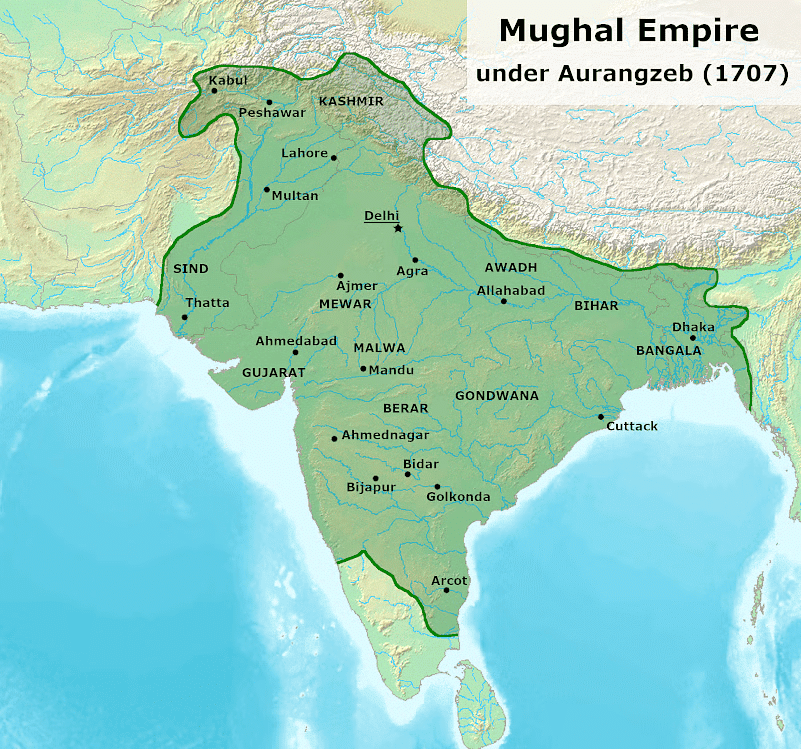 Mughal Empire
Mughal Empire
- Ruling over a vast area like the Indian subcontinent, which was home to many different people and cultures, was a challenging job for any leader in the Middle Ages. Unlike their predecessors, the Mughals established an empire that lasted longer than anyone had thought possible. Starting from the late sixteenth century, they expanded their kingdom from Agra and Delhi, and by the seventeenth century, they controlled almost the entire subcontinent. They set up systems of administration and governance that lasted beyond their reign, leaving behind a political legacy that future rulers could not ignore.
- The Mughals were descendants of two notable lineages. On their mother’s side, they traced their roots to Genghis Khan, the Mongol leader who ruled parts of China and Central Asia. From their father's side, they were heirs to Timur, the ruler of Iran, Iraq, and modern-day Turkey. However, the Mughals preferred not to be called Mughal or Mongol due to Genghis Khan's association with mass killings and competition with the Uzbegs. Instead, they took pride in their Timurid heritage, especially because their ancestor had captured Delhi in 1398.
- Their influence continued even after they lost power, shaping how India was governed. Today, the Prime Minister of India addresses the nation on Independence Day from the Red Fort in Delhi, which was once the home of the Mughal emperors.
Key Changes Made:
- Incorporated missing lines: Added details about the lineage of the Mughals and the significance of the Red Fort.
- Replaced incorrect lines: Updated the initial statements to accurately reflect the historical context and achievements of the Mughals.
- Removed out-of-scope content: Eliminated irrelevant hypothetical scenarios and activities.
- Ensured natural flow: Maintained coherence and logical progression throughout the document.
Who were the Mughals?
The Mughals were the descendants of two influential lineages: Genghis Khan and Timur.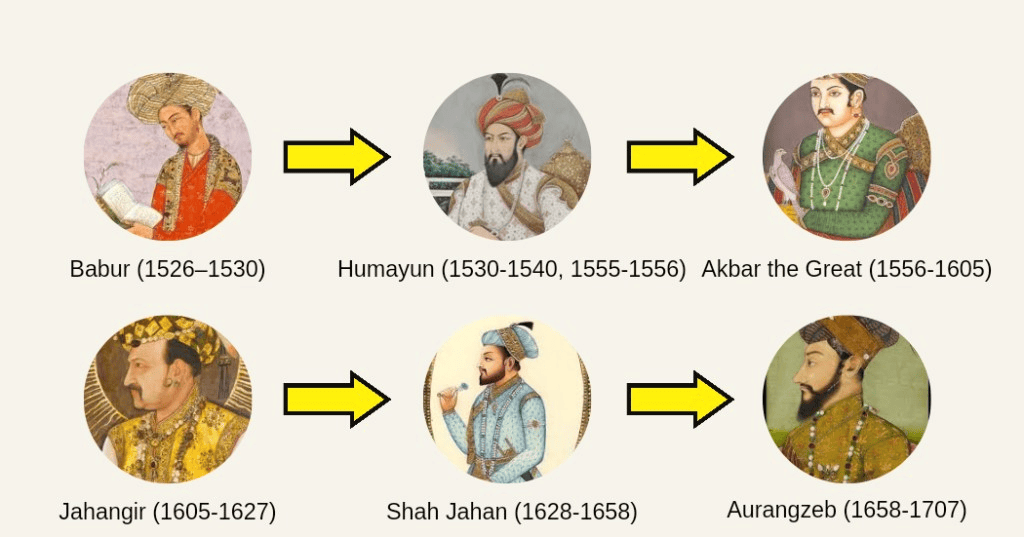 Mughal Lineage
Mughal Lineage
- Lineage: On their mother's side, they descended from Genghis Khan (died 1227), the Mongol leader who ruled parts of China and Central Asia. On their father's side, they were the successors of Timur (died 1404), the ruler of Iran, Iraq, and present-day Turkey.
- Distancing from Mongol Identity: The Mughals did not want to be referred to as "Mughal" or "Mongol" because Genghis Khan's legacy was associated with the killing of many people. It was also linked to the Uzbegs, their Mongol rivals.
- Pride in Timurid Ancestry: The Mughals were proud of their Timurid roots, especially since their ancestor took control of Delhi in 1398. They visually celebrated this ancestry, with each ruler depicted alongside a portrait of Timur.
Mughal Military Campaigns
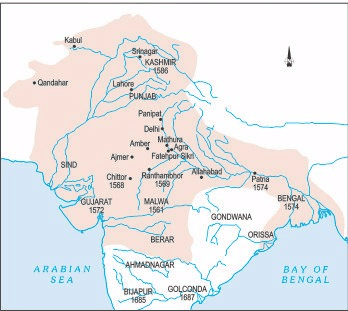 Military campaigns under Akbar and Aurangzeb.
Military campaigns under Akbar and Aurangzeb.
The rise and growth of the Mughal Empire involved a series of carefully planned military campaigns that established its power across the Indian subcontinent. These campaigns were crucial for the expansion of the Mughal Empire, shaping governance and administration in the region.
- Babur’s Early Life and Challenges: Babur became the ruler of Ferghana at the young age of 12 in 1494. He had to abandon his throne due to an invasion by the Uzbegs, another Mongol group. After years of wandering, he captured Kabul in 1504.
- Foundation of the Mughal Empire: In 1526, Babur defeated the Sultan of Delhi, Ibrahim Lodi, at the Battle of Panipat. This victory enabled him to take control of Delhi and Agra, marking the beginning of the Mughal Empire. Babur is recognised as the founder of this empire.
- Ruling over such a vast area as the Indian subcontinent, with its varied peoples and cultures, was a significant challenge for any ruler during the Middle Ages.
- Unlike their predecessors, the Mughals created a lasting empire and achieved what seemed possible only for short periods.
- From the late sixteenth century, they expanded their territory from Agra and Delhi, and by the seventeenth century, they governed almost the entire subcontinent.
- They established administrative systems and governance ideas that continued to influence future rulers.
- Today, the Prime Minister of India addresses the nation on Independence Day from the Red Fort in Delhi, which was once the residence of the Mughal emperors.
Mughal Traditions of Succession
Division of Inheritance in Mughal Tradition
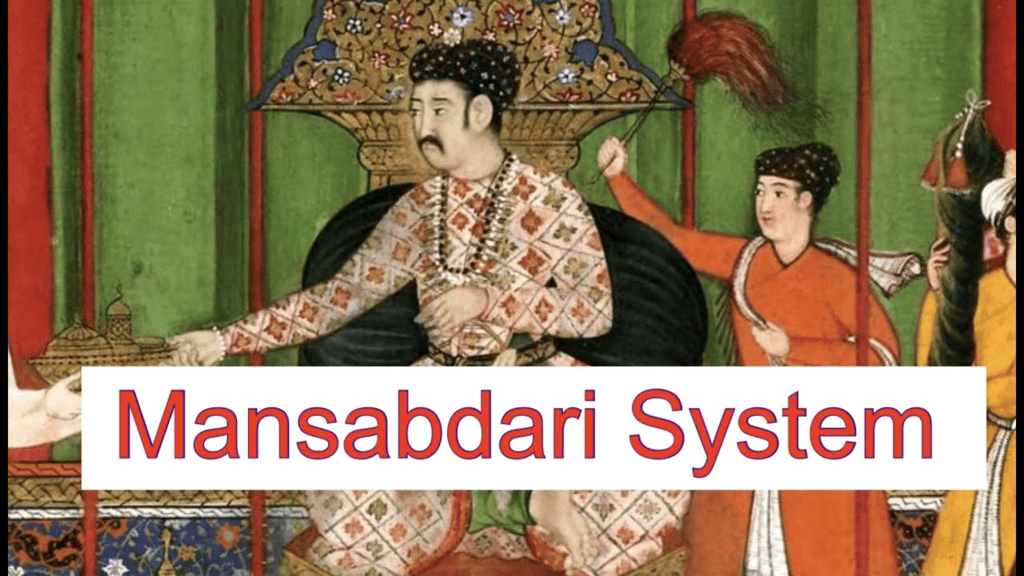
- The Mughals did not practise primogeniture, where the firstborn son inherits everything. Instead, they followed the Mughal and Timurid custom of coparcenary inheritance, sharing the estate among all sons.
- Which do you consider a fairer way to divide inheritance: primogeniture or coparcenary?
Mughal Relations with Other Rulers
The Mughal Empire's dealings with other rulers involved military conquests, strategic alliances, and careful governance and taxation.
- Military Campaigns and Expansion: Mughal leaders often launched campaigns against those who resisted their rule. As the empire grew, many rulers, such as the Rajputs, willingly allied with them, often marrying their daughters into Mughal families and attaining high positions.
- Mansabs and Jagirs: The Mughals increased their territories by granting honourable positions (mansabs) and land (jagirs) to allied rulers, effectively integrating different regions into the empire.
- Taxation and Treatment of Defeated Rulers: The main income for the Mughals came from taxes on agricultural goods collected from peasants. The Sisodiya Rajputs of Mewar initially resisted Mughal control but were treated with respect after their defeat. By balancing defeat with dignity, the Mughals gained influence over many kings and chiefs, who were treated honourably and given back their lands (watan) as assignments (watan jagir).
Mansabdars and Jagirdars
The Mughal system of administration depended on a detailed network of mansabdars and jagirdars to handle military and financial duties, which presented various opportunities and challenges for governance.
- Mansabdars and Recruitment: The Mughal Empire brought together a wide range of individuals, such as Turkish nobles, Iranians, Indian Muslims, Afghans, Rajputs, and Marathas, to serve as mansabdars. A mansabdar is someone who holds a mansab, which is a position or rank. The ranks of mansabdars determined their status, salary, and military obligations. Each mansabdar was responsible for maintaining a specific number of sawar or cavalrymen.
- Jagirs and Revenue System: During Akbar's reign, jagirs were evaluated to ensure their revenues were approximately equal to the mansabdar's salary. However, by Aurangzeb's time, this balance often did not exist, with actual revenues frequently falling short of the assigned amounts. The growing number of mansabdars also led to delays in receiving jagirs, creating a shortage of these grants. Mansabdars were supposed to receive their salaries through jagirs, but the discrepancies in revenue often caused delays.
- Administrative Challenges: Most mansabdars did not directly manage their jagirs, instead relying on servants for revenue collection. This reliance, along with jagirdars' attempts to maximise revenue, resulted in various difficulties. In Aurangzeb's later years, he struggled to control these issues, leading to significant suffering among the peasantry. The Mughals referred to all rural elites as zamindars, which is crucial for understanding their administrative framework.
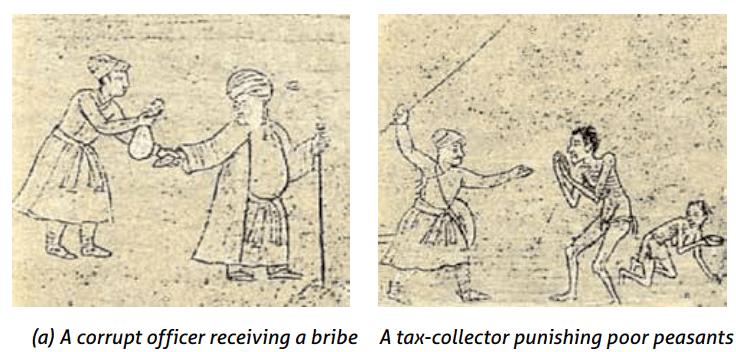
Zabt and Zamindars
- Sources of Income: The Mughal rulers mainly made money by taxing the crops produced by peasants, which was collected by local leaders known as Zamindars.
- Zabt Revenue System: Akbar’s finance minister, Todar Mal, carried out a thorough ten-year survey (1570-1580) to determine cash taxes on crops. Each province was split into revenue circles, each with its own revenue rates for specific crops. This system was called zabt and worked well in regions where Mughal officials could accurately measure land and maintain detailed records. However, this was challenging in provinces like Gujarat and Bengal.
- Zamindar Power and Rebellions: In certain regions, the zamindars held significant power. The harsh practices of Mughal officials could provoke them to revolt. Occasionally, zamindars and local peasants of the same caste would unite to resist Mughal control. These peasant uprisings threatened the stability of the Mughal Empire from the late seventeenth century.
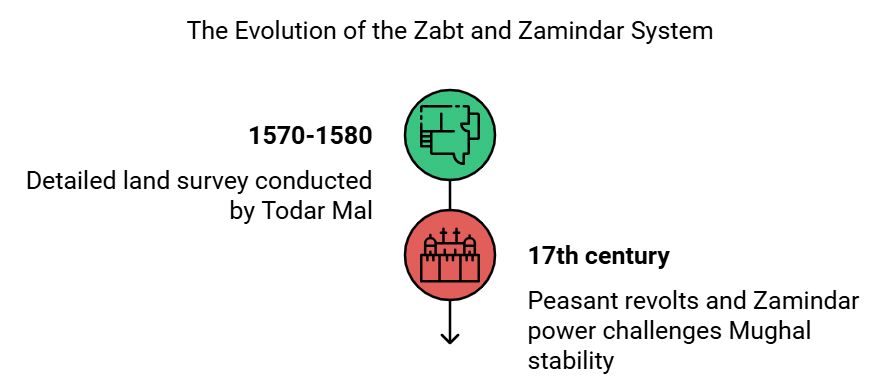
A Closer Look: Akbar’s Policies
Akbar's forward-thinking rules in governance and religion greatly influenced the Mughal Empire. His policies showcased his dedication to tolerance and effective management of a diverse society made up of various religions, cultures, and social classes.
- Religious Discussions and Administration: Akbar engaged in discussions with scholars at the ibadat khana in Fatehpur Sikri to comprehend and harmonise various religious views. This effort resulted in the creation of the Sulh-i kul policy, aimed at fostering universal peace among all faiths.
- Governance Structure: He organised his empire into regions called "subas," each overseen by a governor known as a Subedar. This structure allowed nobles to hold significant power, but Akbar also established checks to prevent any one noble from gaining too much influence.
- Documentation and Legacy: The rules and accomplishments of Akbar were chronicled in a book titled the "Akbarnama" by Abul Fazal. The third volume, Ain-i Akbari, focuses on the administration and policies during Akbar's reign. His principles on religious tolerance and strong governance had an impact on future rulers, including Jahangir and Shah Jahan.

The Mughal Empire in the 17th Century and After
- The effective administration and military of the Mughal Empire resulted in significant economic and trade success.
- Visitors from abroad described it as a legendary place of riches, yet they were shocked by the widespread poverty alongside the immense wealth. The differences were stark.
- Records from the twentieth year of Shah Jahan's reign indicate that there were only 445 high-ranking mansabdars out of 8,000 total. This small group, just 5.6%, received 61.5% of the empire’s total revenue as salaries for themselves and their soldiers.
- The Mughal emperors and their mansabdars spent a lot on goods and wages. This spending helped artisans and peasants, but the way revenue was collected left very little for the main producers—peasants and artisans. The poorest struggled to survive and could barely think about investing in more tools and supplies to boost productivity.
- Richer peasants, artisans, merchants, and bankers benefited from this economic climate.
- The vast wealth and resources of the Mughal elite made them very powerful in the late seventeenth century. As the Mughal emperor's power weakened, his officials grew influential in their regions. They formed new dynasties and controlled provinces like Hyderabad and Awadh.
- Even though they continued to acknowledge the Mughal emperor in Delhi as their leader, by the eighteenth century, the provinces had developed their own independent political identities.
Key Features of the Mughal Empire
- Wealth and Luxury: The Mughals were renowned for their wealth and luxury, with emperors like Aurangzeb and Shah Jahan known for their extravagant lifestyles and magnificent buildings.
- Taxes and Trade: The empire flourished on taxes from trade in goods such as spices, textiles, and metals.
- Strong Control: The Mughals maintained a strong military and effective governance, ensuring efficient trade and tax collection.
- Cultural Blend: They combined Persian, Indian, and Islamic cultures, evident in their art, architecture, and everyday life.
Important Dates
- 1227: Genghis Khan died.
- 1405: Timur died.
- 1526-1530: Babur's reign began. He lost his ancestral throne to the Uzbeg invasion. In 1526, he captured Delhi by defeating Ibrahim Lodi, establishing the Mughal Empire.
- 1539: Sher Shah defeated Humayun at Chausa.
- 1540: Sher Shah again defeated Humayun at Kanauj.
- 1556: Humayun recaptured Delhi. Akbar became the Mughal Emperor at 13.
- 1568: Akbar took over the Sisodiya capital of Chittor.
- 1569: Akbar captured Ranthambhore.
- 1605-1627: Jahangir ruled as Mughal Emperor in Delhi.
- 1627-1658: Shah Jahan reigned over Delhi.
- 1632: Shah Jahan annexed Ahmadnagar.
- 1658-1707: Aurangzeb ruled over Delhi.
- 1685: Aurangzeb annexed Bijapur.
- 1687: Aurangzeb annexed Golconda.
- 1698: Aurangzeb campaigned against the Marathas in the Deccan.
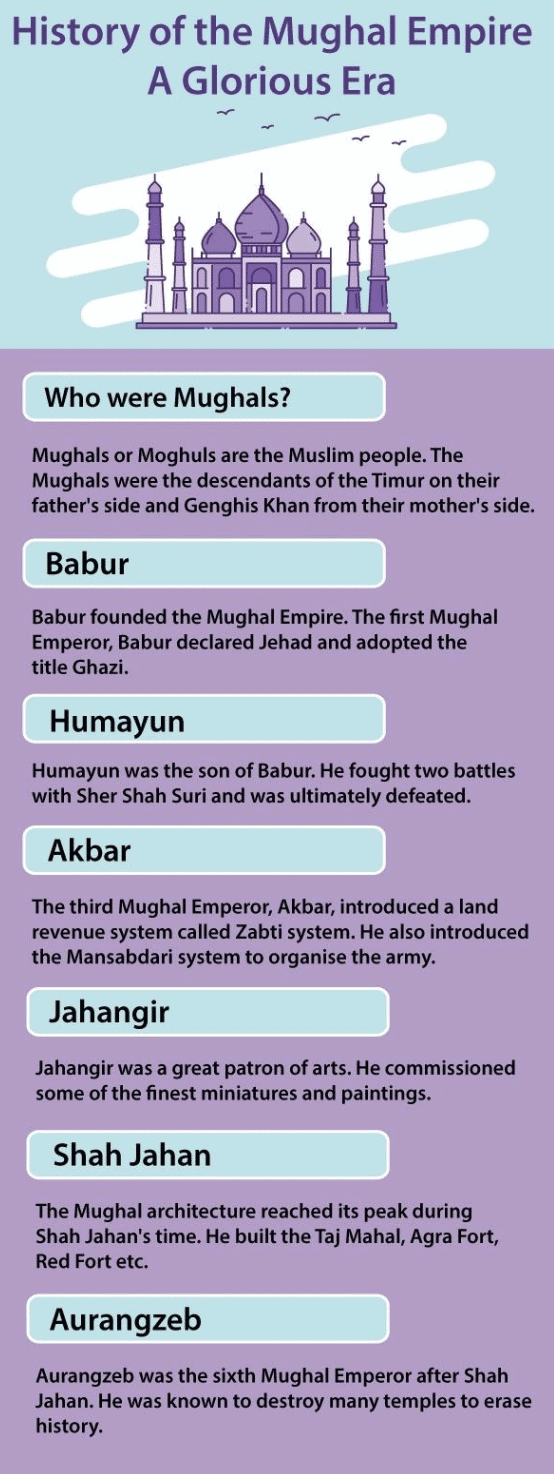
|
63 videos|371 docs|46 tests
|
FAQs on Class 7 History Chapter 4 Notes - The Mughal Empire
| 1. Who were the Mughals and what was their significance in Indian history? |  |
| 2. What were the main military campaigns undertaken by the Mughals? |  |
| 3. How did succession work in the Mughal Empire? |  |
| 4. What role did mansabdars and jagirdars play in the Mughal administration? |  |
| 5. What were Akbar's notable policies that influenced the Mughal Empire? |  |

















